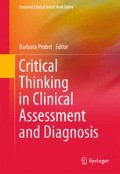Abstract
A conceptual introduction sets forth the book’s aim: to guide clinical social work students (and practicing clinicians) to explore assessment from a range of theoretical frameworks, each with its own emphasis, limitations, and form of evidence, and to think critically about what each perspective has to offer, takes for granted, omits, and counts as knowledge. It begins by exploring the meaning of the key terms “critical thinking,” “diagnosis,” and “assessment” and draws on both theory and research to trace how these concepts have been addressed in social work education and practice. Following an overview of the book’s structure and content, including introduction to the case of Ray (a case that will be used throughout the chapters and analyzed from each clinical perspective), the introduction concludes with specific suggestions for educators about ways to use the book to develop complex, reflexive, and critical thinking in their students.
Access this chapter
Tax calculation will be finalised at checkout
Purchases are for personal use only
References
Epple, D. M. (2007). Inter and intra professional social work differences: Social Work’s challenge. Clinical Social Work Journal, 35, 267–276.
Gambrill, E. (2005). Critical thinking, evidence-based practice, and mental health. In S. A. Kirk (Ed.), Mental disorders in the social environment: Critical perspectives (pp. 247–269). New York: Columbia University Press.
Ishibashi, N. (2005). Barrier or bridge? The language of diagnosis in clinical social work. Smith College Studies in Social Work, 75(1), 65–80.
Kirk, S. A., Siporin, M. & Kutchins, H. (1989). The prognosis for social work diagnosis. Social Casework: The Journal of Contemporary Social Work. 295–304.
Kirk, S. A. (2005). Critical perspectives. In S. A. Kirk (Ed.), Mental disorders in the social environment: Critical perspectives (pp. 1–22). New York: Columbia University Press.
Kutchins, H. & Kirk, S.A. (1995). Should DSM be the basis for teaching social work practice in mental health? No! Journal of Social Work Education, 31(2), 159–165.
Lacasse, J. R. & Gomory, T. (2003). Is graduate social work education promoting a critical approach to mental health practice? Journal of Social Work Education, 39(3), 383–408.
Mattaini, M. A. (2005). Mapping practice: Assessment, context, and social justice. In S. A. Kirk (Ed.), Mental disorders in the social environment: Critical perspectives (pp. 62–82). New York: Columbia University Press.
McQuaide, S. (1999). A social worker’s use of the diagnostic and statistical manual. Families in Society, 80(4), 410–417.
Mullen, E. J. & Streiner, D. L. (2004). The evidence for and against evidence-based practice. Brief Treatment and Crisis Intervention, 4(2). 111–121.
Newman, B. S., Clemmons, V. & Dannenfelser, P. L. (2007). The diagnostic and statistical manual of mental disorders in graduate social work education: Then and now. Journal of Social Work Education, 43(2), 297–307.
Probst, B. (2012). Diagnosing, diagnoses, and the DSM in clinical social work. Families in Society, 93(4), 255–263.
Probst, B. (2013) Walking the tightrope: Clinical social workers’ use of diagnostic and environmental perspectives. Clinical Social Work Journal, 41(2), 184–191.
Raffoul, P. R. & Holmes, K. A. (1986). DSM-III content in social work curricula: Results of a national survey. Journal of Social Work Education, 22(1): 24–31.
Reamer, F. G. (2005). Social work, mental health, and mental disorders. In S. A. Kirk (Ed.), Mental disorders in the social environment: The ethical dimensions (pp. 411–429). New York: Columbia University Press.
Thyer, B. A. (2004). What is evidence-based practice? Brief Treatment and Crisis Intervention, (2). 167–176.
Turner, F. J. (2002). Diagnosis in social work: New imperatives. Binghamton, NY: Haworth Press.
Williams, J. B. W. & Spitzer, R. L. (1995). Should DSM be the basis for teaching social work practice in mental health? Yes! Journal of Social Work Education, 31(2), 148–153.
Author information
Authors and Affiliations
Corresponding author
Editor information
Editors and Affiliations
Rights and permissions
Copyright information
© 2015 Springer International Publishing Switzerland
About this chapter
Cite this chapter
Probst, B. (2015). Why This Book Is Needed. In: Probst, B. (eds) Critical Thinking in Clinical Assessment and Diagnosis. Essential Clinical Social Work Series. Springer, Cham. https://doi.org/10.1007/978-3-319-17774-8_1
Download citation
DOI: https://doi.org/10.1007/978-3-319-17774-8_1
Published:
Publisher Name: Springer, Cham
Print ISBN: 978-3-319-17773-1
Online ISBN: 978-3-319-17774-8
eBook Packages: Humanities, Social Sciences and LawSocial Sciences (R0)

